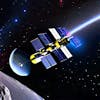S03E19: Cosmic Dispatches: Reusing Rockets, Revolutionary Deliveries, & Solar Spectacles

**Hosts:** Anna and the Astronomy Daily Team
---
**Episode Summary:**
Blast off with Anna and the Astronomy Daily Team in this captivating episode, where the cosmos unveils its latest marvels and milestones. Today, we celebrate SpaceX's 260th reflight...
**Hosts:** Anna and the Astronomy Daily Team
---
**Episode Summary:**
Blast off with Anna and the Astronomy Daily Team in this captivating episode, where the cosmos unveils its latest marvels and milestones. Today, we celebrate SpaceX's 260th reflight of an orbital class rocket, signaling a sustainable future in space travel. We'll also explore an audacious partnership between Taobao and Chinese rocket company Space Epoch, aiming to revolutionize global deliveries with astonishing speed. Our cosmic journey then takes us to NASA's open data initiative as they gear up for the 2024 total solar eclipse, inviting public participation in a rare celestial event. We'll visit the lunar surface with Japan's resilient moon probe SLIM, which has awakened from the darkness to continue its scientific mission. Lastly, we introduce the Helioviewer Project's Eclipse Watch, an innovative tool that brings the sun's corona to our screens daily. Strap in for an episode that traverses the boundaries of space innovation and stargazing splendor.
---
**Featured Topics:**
1. **SpaceX's Reusable Rocket Milestone:** Join us in applauding SpaceX's landmark achievement in rocket reusability and the implications for the future of space exploration.
2. **Taobao & Space Epoch's Cosmic Commerce:** Discover how e-commerce and aerospace are merging to potentially deliver your packages via rocket, redefining global logistics.
3. **NASA's Eclipse of Open Data:** Learn about NASA's commitment to open science and how you can be a part of the 2024 total solar eclipse's scientific endeavors.
4. **Japan's Moon Probe Triumph:** Hear the inspiring tale of Japan's moon probe SLIM, which has overcome the harsh lunar environment to continue its quest for knowledge.
5. **Daily Dose of Solar Majesty:** Experience the grandeur of the sun's corona every day with the Helioviewer Project's Eclipse Watch, building excitement for the upcoming solar eclipse.
---
**Additional Information:**
To delve deeper into the universe's secrets, journey over to astronomydaily.io, where you can access a wealth of resources, listen to past episodes, and keep abreast of the latest astronomical news. For a daily dispatch from the stars, subscribe to our newsletter, and join the celestial conversation by following @astrodailypod on X. Your adventure through the cosmos continues with us.
---
**Closing Remarks:**
As we conclude this stellar episode, we thank you for joining us on this interstellar voyage. The cosmos is vast and filled with wonders, and we're here to help you navigate its expanse. Until our next cosmic encounter, this is Anna, wishing you clear skies and boundless curiosity. Keep gazing upward, for the universe is yours to discover.
---
**Host Sign-off:** Anna: "Thank you for tuning into Astronomy Daily. Until we traverse the stars together again, this is Anna, signing off. Dream big, fellow stargazers!
This episode of Astronomy Daily is brought to you with the support of NordPass...the password manager. Remove all that angst from your life for very little (and we mean little!) money with the special deal for our listeners. Check the details out at www.bitesz.com/nordpass
(00:00) Astronomy Daily podcast series three, episode 19 comes out today
(01:51) SpaceX's Falcon 9 rocket successfully launched 23 satellites into low Earth orbit
(03:32) Space epic announces partnership with Alibaba to develop reusable rockets for ecommerce
(05:46) NASA is embracing open data principles ahead of the 2024 total solar eclipse #space #astronomy #news #podcast #astronomydaily #nasa #spacex
Become a supporter of this podcast:
Astronomy Daily podcast S03E19
Anna: Welcome to Astronomy Daily. The podcast series three, episode 19 your conduit to the stars and beyond. I'm your host, guiding you through the cosmic frontier, where we'll unravel the latest and most thrilling news from the cosmos. In this episode, we're set to embark on a journey across a multitude of celestial milestones and innovations that are reshaping our understanding of space and our place within it. Our, uh, cosmic itinerary today includes marveling at a significant achievement by SpaceX, marking a new era in space travel sustainability. We'll also peek into an ambitious initiative that sees a union between e commerce titan Taobao and chinese rocket company space epoch as they embark on a journey to revolutionize global deliveries with astonishing speed. We continue our ascent as we delve into NASA's commitment to open data and its preparatory efforts for an astronomical highlight of the decade, the highly anticipated total solar eclipse of 2024. The eclipse promises to offer a spectacle while furthering our scientific knowledge, and NASA is inviting us all to take part in this rare event. Our m quest will also take us to the lunar surface, where Japan's moon probe defies the odds, awakening from the darkness of space to once again gather precious information from our celestial neighborhood. Lastly, we'll introduce an innovative tool by the Helio viewer, Project Eclipse Watch, that allows us to witness the grandeur of the sun's corona every day as we count down to the eclipsing moment. So, stargazers, ensure your telescope lenses are polished and your curiosity is fueled as we set off to explore these celestial happenings that spell an exciting chapter in our astronomical story. Join me in marveling at human ingenuity and the mysteries that await us among the stars.
SpaceX's Falcon 9 rocket successfully launched 23 satellites into low Earth orbit
Let's get started. Execution the astronomy daily podcast. In a remarkable testament to the prowess of modern engineering, SpaceX has etched its name into the history books yet again, achieving their 260th reflight of an orbital class rocket. This time, they've propelled 23 satellites into the beckoning embrace of low Earth orbit, continuing their ambition to make space more accessible. Led by the visionary Elon Musk, SpaceX has revolutionized space travel with their hallmark of innovation. The reusable rocket. The Falcon Nine's first stage booster, designed for controlled landings and rapid reusability, offers a glimpse into the sustainable future of space exploration. M this particular launch not only signifies habitual progression for the industry, but underscores a um march towards economic viability in the cosmos. As the Falcon Nine rocket soared through the atmosphere and beyond, it left behind a resounding message that the barriers of space are not as insurmountable as once thought. The booster, which has heralded many payloads before returned to Earth, touching down aboard the drone ship, just read the instructions in a triumphant display of precision and durability. Laughter mixed with applause may have been heard from onlookers as SpaceX enthusiasts humorously quipped, this rocket seems safer than a Boeing, signifying the public's growing trust in these technological marvels. The company's persistence in refining reusability shines through in launches like these, each one carving a deeper foundation for the next era of space travel and perhaps the next giant leap for mankind.
Space epic announces partnership with Alibaba to develop reusable rockets for ecommerce
Let's shift our gaze from the stars to a groundbreaking venture right here on Earth, or rather, the earth's orbit. In a bold fusion of e commerce and aerospace, space epic, a, uh, chinese rocket maker, has announced an ambitious partnership with Alibaba's online shopping behemoth Taobao. This forum of titans is on a quest to reinvent global logistics through the power of reusable rockets. The idea is nothing short of revolutionary. Envision express deliveries that span continents with the precision and speed of an orbital shuttle, each reaching its destination in as little as 1 hour. The sheer scale is breathtaking. A rocket capable of hauling ten tons of cargo within a container of 120 m³, this initiative is far more than just about speed. It is a testament to human ingenuity and our relentless pursuit of efficiency. We are witnesses to the amalgamation of two distinct e commerce and aerospace, yielding a new era where your deliveries could orbit the earth before they land softly at your doorstep. Space epic is not merely aiming for the stars. They're designing the Yuanxing one, a rocket that has proven itself through ignition and offshore recovery tests last year, with President Xi Jinping's call to expand strategic industries, including the commercial space sector, China's tapestry of innovation is being woven with threads of ambition and vision. However, this project is still in its infancy, and the technological labyrinth that it must navigate is treacherous and intricate. Despite securing substantial funding, space epic acknowledges that realizing such a future will not come m without its challenges in the short term. Compounding the fascination are the 17 commercial launches of last year, with China claiming a new record of 67 orbital launches, signifying a steadfast march toward commercial space leadership. Imagine the possibilities that lie ahead, a world where the morning skies are not just the province of birds and planes, but of rockets returning from their global jaunts, changing everything we know about getting goods from one point to another. As we contemplate such a future, one can't help but wonder what this could mean for our global community, our economies, and our skies.
NASA is embracing open data principles ahead of the 2024 total solar eclipse
As we turn our gaze towards the heavens, another exceptional event awaits us, the 2024 total solar eclipse. During such eclipses, our planet is treated to a truly majestic spectacle that not only captivates casual stargazers, but also represents an invaluable research opportunity for scientists. This time, NASA is taking the extraordinary step of fully embracing open data principles, creating a remarkable synergy between public participation and scientific research. In anticipation of the eclipse's path from Mexico to Canada, the space agency is committed to ensuring that the data gathered during the eclipse will be as widely available as possible. This isn't simply a matter of public record. It's a foundational aspect of NASA's open science initiative, which is about democratizing access to data and inviting widespread collaboration across the scientific community and the public. This open data approach isn't just rhetoric. It's embodied in practical tools and projects designed to draw in observer participation. Take, for instance, NASA's sun sketcher platform. It's set to become a hub for enthusiasts to sketch the sun's corona during the eclipse, contributing valuable qualitative data. Meanwhile, the citizen Kate experiment will mobilize volunteers across the eclipse path to participate in data collection, turning a celestial event into a collective scientific pursuit. Across the United States, in the small town of Uvalde, Texas, NASA's transform to open science team will be engaging with the local community. The team's focus is not just to view the eclipse, but to educate on the vast amounts of data driven discoveries that can be obtained from such events. And soon after the eclipse, the resulting data will be shared with the world freely and publicly, fostering interdisciplinary research and deepening our global understanding of solar phenomena. This open data policy also extends beyond the moments of total eclipse. NASA is devoted to the broader implications of such accessible information, knowing that this data is not only a catalyst for scientific discovery, but also a way to integrate science more deeply into the fabric of society. An eclipse might be momentary, but the knowledge and curiosity it kindles are everlasting, much like the celestial bodies that dance across our skies. The Astronomy Daily podcast Japan's ambitious lunar exploration endeavors have taken a leap forward with the Japan Aerospace Exploration Agency JAXA, sharing news that stirs both pride and admiration. The agency's smartlander, for investigating moon, affectionately termed slavery slim but also known as the moon sniper, has once again defied the odds. After its touchdown in January, this resilient robotic explorer marked Japan as only the fifth country to execute a soft landing on the moon, joining an elite group of spacefaring nations. But the journey for slim has been far from simple. The lunar lander faced a harsh and unforgiving environment where it encountered a challenge of lunar proportions, surviving the long and extremely cold lunar night. With temperatures plunging to a bleak negative 130 degrees celsius, the probe's survival is nothing short of a technological triumph, especially considering the initially unfavorable position of its solar panels. Against all predictions, Slim roused itself from its slumber after the first lunar night and began communicating with Earth. This display of engineering tenacity was repeated after the second night, with JAXA confirming the successful collection and transmission of new lunar images, enriching our understanding of Earth's closest celestial neighbor. Despite some malfunctions noted in the Landers multiband camera system, the instrument continues to function and promises to unlock further mysteries of the moon. Through Slim, JAXA looks to scrutinize the moon's geological past with hopes pinned on analyzing rocks from the lunar craters believed to contain pristine material dating back to the moon's formation. As JAXA announces the lander's temporary hibernation once more, there is a collective breath held in anticipation for what discoveries will emerge. When it wakes, the probe stands as a shining beacon of Japan's commitment to space exploration, marking a stance of perseverance and dedication in the cosmic quest for knowledge. For those of us who find the celestial dances of our universe thrilling, the Helio viewer project has unveiled a groundbreaking new feature called Eclipse Watch. This remarkable tool is designed to satisfy our solar curiosity daily. Offering eclipse like snapshots of the sun's glowing corona. It capitalizes on the exceptional capabilities of the solar and heliospheric Observatory, widely known as SoHo, which operates in partnership between NASA and the European Space Agency. Think of eclipse watch as your personal observatory booth, accessible at any time, turning your gaze to the outermost atmosphere of the sun. What makes this so special? It provides an experience akin to observing a total solar eclipse, but without the years long intermission between such awe inspiring events. The breathtaking imagery that Soho gathers showcases intricate features of our star, like the streaming hot gas that escapes into the void of space and gives us vital insights into solar phenomena that we otherwise couldn't study without the moon's assistance. If you've ever watched an eclipse, you'll remember that as the moon blocks out the sun's overpowering light, it reveals the corona's delicate tendrils, something Soho's coronagraphs replicate. By creating their own artificial eclipses in space, this tool enhances the anticipation for the next total solar eclipse visible on Earth on April 8, 2024, which will cast its shadow over a swath stretching from Mexico to Canada. Soho, a mission with a legacy since its 1995 launch, continues to deepen our understanding of solar events and the ceaseless solar wind that permeates our solar system. With over 100 images captured each day by the large angle and spectrometric coronagraph experiment aboard Soho, Eclipse Watch serves as both an educational resource and a delightful tease for what's forthcoming in the skies as we await the historic solar event. Eclipse watch not only tempts our imagination with daily celestial spectacle, but also exemplifies our never ending human quest to understand the grand tapestry of our cosmos. It is a testament to our ability to pull the corners of space closer to Earth, to relish and marvel at our sun's quiet magnificence every single day. As we reach the end of another enlightening episode here at Astronomy daily, the podcast, I'd like to extend a heartfelt thank you for joining me on this celestial journey. Our expedition through the vastness of space today has shed light on the dazzling achievements of SpaceX, the innovative aspirations of China's Taobao, teaming up with space epic, NASA's embrace of open science principles in preparation for the 2024 solar eclipse, the remarkable survival and contributions of Japan's moon probe slim, and the immersive experience offered by the helio viewers eclipse watch tool. But the conversation doesn't have to end here. To continue exploring the wonders of the cosmos, I invite you to set course for astronomy daily IO. It's a cosmic hub where you'll discover all of our back episodes, along with the latest astronomical discoveries, which are updated constantly to satisfy your stargazing curiosities. And if you're craving a more personal dispatch from the universe, consider signing up for our free astronomy daily newsletter, your regular update from the stars delivered directly to your inbox. Lastly, I encourage you to connect with us on x by following at astroDailypod, where our updates on space news will keep your astrophysical knowledge at the helm of contemporary discoveries. So until next time, keep your eyes to the skies and your mind open to the wonders above. This is Anna, your host on this episode of Astronomy Daily, the podcast signing off. Clear skies and cosmic dreams to all.
Generic: The Astronomy Daily Podcast.
New to Astronomy Daily - The Podcast?
Here are some great episodes to start with.














